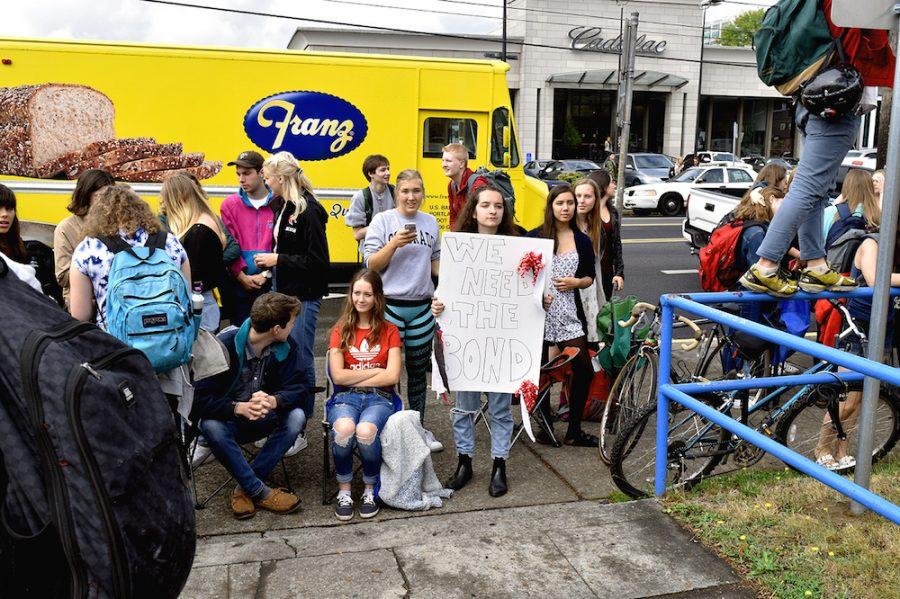Benson locked in while Lincoln walks out
Lincoln students protest a police line at Benson’s doors during their walkout on Sept. 7.
When the Portland Public Schools board voted on Sept. 6 to leave a $750 million bond on the May ballot, Lincoln students saw the decision as a call to action.
In a last-ditch effort to get the board to change its mind and put the measure on the November ballot, where it could be considered by voters going to the polls for a presidential election, they decided to stage a walkout.
On Sept. 7, as many as 1,000 Lincoln students walked out of school at about 9 a.m. And while the board did not reconsider, students felt their demonstration showed solidarity and illustrated the importance of the measure.
Still, they were disturbed that fellow students at Benson High School were restricted from joining them.
The measure, if passed, will rebuild not only Lincoln, but Benson and Madison high schools.
The situation unfolded as follows: After Lincoln students left school, they first walked to Pioneer Courthouse Square and then to City Hall. From there, they crossed the Hawthorne Bridge and turned north toward Benson, where they hoped to enlist the support of students at that school.
But that didn’t happen.
For one thing, Benson students apparently were not notified about the walkout until hearing about it on social media.
Cobee Crawford, a freshman at Benson, was one of the students surprised when Lincoln students and a few teachers arrived at the school.
“I heard about the walkout; I just didn’t realize they were coming to us at Benson,” said Crawford.
He said word of the demonstration spread around the school, however, nobody was completely sure of what they were being allowed to do.
“We didn’t know what we could do, once I asked a teacher, they said walking out would mean we couldn’t that we could not return to the school property,” said Crawford.
In addition, once Lincoln students arrived, the Benson administration initiated a lockout, meaning no students could enter or exit the school. Signs were placed on all doors in the school reading “LOCKOUT: NO ONE IN OR OUT,” a similar response to when a violent crime occurs in the area.
That move by the administration, on top of police appearing at the school, led many Benson students to stay put or cheer on Lincoln students from windows and doorways. There was confusion on why police were present at the protest.
“We asked the police if we left if they would arrest us, but they said they couldn’t,” said Crawford.
According to PPS lockout standards, police are called to barricade school doors under certain circumstances. But protest leaders and students argue that there was never any threat for violence and was no need to lockout Benson.
“Ordering officers to barricade the entrance limits free speech rights without increasing safety,” said Lincoln and Benson protest leaders in an official press release.
Some suggested having police on hand was an act of racism. Lincoln is a predominantly white school, while Benson is made up mostly of students of color.
“I think it may have been an act of unintentional racism,” Crawford said.
Trevor Todd, a Spanish teacher at Lincoln and one of a few staff members who escorted students during the walkout, was among those disappointed with the district’s reaction.
“It was very troubling to know that one school was allowed to protest when another across the river was not,” Todd said.
Teressa Raiford, leader of “Don’t Shoot Portland,” felt the lockout was an act of racism and dishonesty from the district. In an open letter to interim superintendent Bob McMckean, she accused PPS officials of lying, and said they needed to own up to their wrongdoing.
“Our black and brown students should feel like they have equal opportunities, that their voices are listened to and heard,” said Raiford.
Benson administrations, along with those at PPS, claim that the students had a chance to exit the school if they wanted to during the lockout. However, Raiford argued against that point.
“What student, especially in the light of of the national epidemic of police shooting, would feel free to walk by signs that said to not go outside?” said Raiford.
Protest leaders complained, saying protesters were respectful and fighting for what they deserved. They also noted that there were six teachers in attendance, monitoring the situation.
Neither PPS nor Benson released statements about why they lockout took place. But PPS policy states that a lockout is ordered when “a threat outside the school” takes place.
Still, a few Benson students managed to get out of school and join in. Some chanted and clapped from the school’s front windows while others stood at the door ways. They stood with Lincoln, urging to have a meeting to get a November vote for the bond.
“Lincoln deserves a new school, they really need it,” Crawford said.
Todd spoke highly of the walkout students, happy and impressed with the unification of two schools.
“It was an act of solidarity that I was proud to witness,” said Todd.

